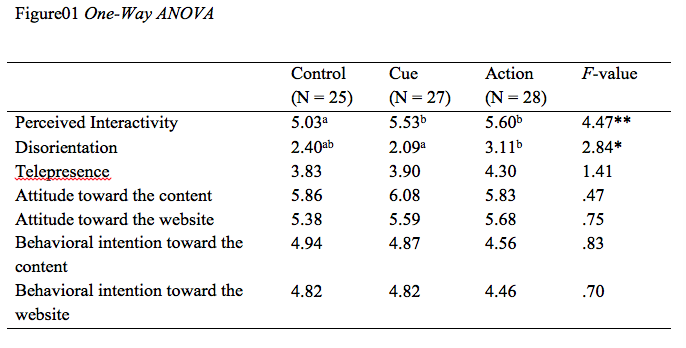Media Effects Research Lab - Research Archive
Interactivity cues:
Student Researcher(s)
Alyssa Appelman (Ph.D Candidate);
Youngjoon Choi (Ph.D Candidate);
Ashley Han (Ph.D Candidate);
Bo Zhang (Ph.D Candidate);
Faculty Supervisor
INTRODUCTION
In recent years, as both computing power and the ability to share media over the Internet have increased, there has been a booming interest in new modes of media consumption and interaction. In particular, there has been a rise in interest in the possibilities of interactive online environments. While such interactive environments have been utilized in many areas, they have show particular promise in being used to create virtual tourism experiences which offer people from around the world convenient access to remote tourist destinations that might otherwise be unavailable to them.
Our main interest is to explore the effects of presence of visual interactivity cues (interface elements that imply interactivity visually) and actual use of interactivity function on user experience during interaction, perceptions of the content and website, and information processing type.
RESEARCH QUESTION / HYPOTHESES:
RQ1: For virtual travel site users, controlling for content, what is the relationship between interactivity mode (control, cues, and actions) and user experience?
H1a: Interactivity action and interactivity cues will lead to a higher level of perceived interactivity than the control group.
H1b: Interactivity action will lead to a higher level of disorientation than interactivity cues and the control group.
H1c: Interactivity action will lead to a higher level of telepresence than interactivity cues and the control group.
H2a: Interactivity action and interactivity cues will lead to a higher level of attitude toward the content than the control group.
H2b: Interactivity action and interactivity cues will lead to a higher level of attitude toward the website than the control group.
H3a: Interactivity action and interactivity cues will lead to a higher level of behavioral intention toward the content than the control group.
H3b: Interactivity action and interactivity cues will lead to a higher level of behavioral intention toward the website than the control group.
H4a: Interactivity action will lead to more systematic processing than interactivity cues.
H4b: Interactivity cues will lead to more heuristic processing than interactivity action.
METHOD
In order to examine the role that interactivity cues plays in users' experience of online virtual tourist site, an experimental lab study was conducted using students from a major American university as participants. There were three conditions in the experiment: control, cues, and action conditions.
Upon arrival at the computer laboratory, participants were welcomed and asked to read and fill out a paper consent form. After they agreed to participate, participants in the action condition were told that they would be exploring a new travel website for three minutes, and participants in the control/cues conditions were told they would be watching a video demonstration of a new travel website for three minutes. All three groups were told they would be filling out an online questionnaire after the three minutes, and they were given instructions for using the computer and mouse. They also were informed that they could decide to stop participating at any time during the experiment. All of the participants in all of the conditions received the instructions from the same researcher. After the oral instructions, participants were instructed to sit down at one of the computer terminals.
The participants then either explored the stimulus website or watched the video demonstration. After the three minutes, researchers walked to each computer, closed the website or video, and opened the online questionnaire containing measures of the aforementioned dependent and control variables. Once participants had finished both the stimulus exposure and the questionnaire, they were thanked and dismissed. After all the experimental sessions were completed, the participants were debriefed in their class.
RESULTS
In summary, participants in both the cue and action conditions had a higher level of perceived interactivity than those in the control condition. Also, participants who actually used the cues were more disoriented than those who just saw the cues. However, there were no differences between the cue and action conditions in terms of content and website perceptions. According to the power analysis, the ANOVAs had enough participants to reject medium and large effect sizes, but not enough to reject a small effect size. Also, perceived interactivity was positively associated with website perceptions, and telepresence was moderately related to users’ behavioral intention toward the website. In terms of cognitive processing, participants in the cue condition used more heuristic processing than those in the action condition, but there was no difference for systematic processing.

DISCUSSION/ CONCLUSION
The results showed that users who viewed tutorial with cues and users who actual used the interface exhibited the same level of perceived interactivity, and both were higher than control group. Therefore, this study suggests that travel website designers should pay attention to their cues. For website promotion in particular, the design of the cues themselves seems to be as important as their functionality. For travel website users, this study suggests that video tutorials may be a better way of learning about a tourist destination online. In addition, cues group showed more heuristic processing than the action condition, letting empirical support for the MAIN model.
For more details regarding the study contact
Dr. S. Shyam Sundar by e-mail at sss12@psu.edu or by telephone at (814) 865-2173

